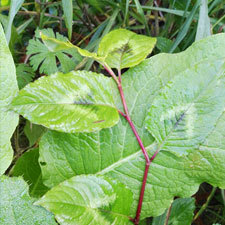 Chinese knotweed
Chinese knotweed
Common name: Chinese knotweed
Botanical name: Persicaria chinensis
Management programme: Advisory
Chinese knotweed, as the name suggests, originates from China but is widespread throughout Asia where it is used in herbal remedies for the treatment of dysentery, eczema, enteritis, and sore throat. It was either potentially introduced to New Zealand for Chinese herbal medicine purposes, or accidentally introduced.
Why is it a pest?
- Chinese knotweed can tolerate a variety of climatic conditions, including shade, high and low temperatures, high salinity and drought.
- It grows quickly to smother other plants.
- Highly invasive plant that quickly smothers available surfaces including other plants and trees.
- Has the ability to smother other plants affecting plant community structure and composition.
- Chinese knotweed has the potential to affect forestry, orchard and nursery operations and become a nuisance plant in home gardens.
Where is it found?
There are no known sites currently in the Bay of Plenty. Chinese knotweed is only known to be present in the Waikato and Auckland.
In its native range it grows in wet valleys, grassy slopes, mixed forests, valleys, and mountain slopes from sea level to 3000m. It could be found in disturbed sites, home gardens, abandoned gardens, riverbanks, roadsides an agricultural land.
Chinese knotweed is very invasive and can grow from seed or vegetative fragments to form new plants.
What does it look like?
- Chinese knotweed can grow as a scrambling vine or as a shrub.
- It is a perennial bushy vine which grows 2–3m high.
- Stems are reddish and have a slight zigzag form.
- Leaves have a very distinctive, 4–16cm long, soft and wavy-edged with a white V-shaped blotch. It has pinkish stems and flowers are cream/pink, growing in clusters.
- Flowers from November to March.
What are the rules?
Advisory
The Bay of Plenty Regional Council does not enforce the control of advisory species. It is landowner/occupier responsibility to manage these pests. Council may provide advice on how to manage or control these species if required.
How do you get rid of it?
- Dig-out (all year) – small patches, dispose by incineration or transfer station.
- Weed mat – Leave for six months minimum.
- Cut and paste with herbicide (all year)
- Stem inject with herbicide (all year)
- Foliar spray (Spring to Autumn)
CAUTION: When using any herbicide or pesticide, PLEASE READ THE LABEL THOROUGHLY to ensure that all instructions and directions for the purchase, use and storage of the product, are followed and adhered to.
Read more on pest control advice, information and regulations.
Images

